It’s late October as I write this. A few weeks ago, I polled over 50 influencer marketers about what’s been working - and what’s changed- in 2025.
Last year’s survey felt different. The tone in 2024 was hopeful, experimental, and ambitious. This year? It’s protective.
Across dozens of responses, one theme stood out: marketers are playing it safe.
Not because they suddenly stopped believing in taking risks, but because they’re under pressure to prove predictable results fast.
With tariffs shaking ecommerce forecasts, teams tightening budgets, and leadership bracing for a slower Q4, marketers did what humans do under pressure: they reached for control.
That instinct rippled through everything. From which channels they invested in, to the types of creators they trusted, to how they structured their deals.
In this report, we’ll look at how that protective mindset changed influencer marketing this year, what marketers gained by playing it safe, what they lost, and how they can move forward with confidence in 2026.
Shrinking the playing field: Fewer channels, faster wins
The first sign of this defensive shift was where marketers chose to show up this year.
Most teams retreated to their comfort zones: 85% of respondents said Instagram was their top sales driver, with TikTok holding steady in second place.
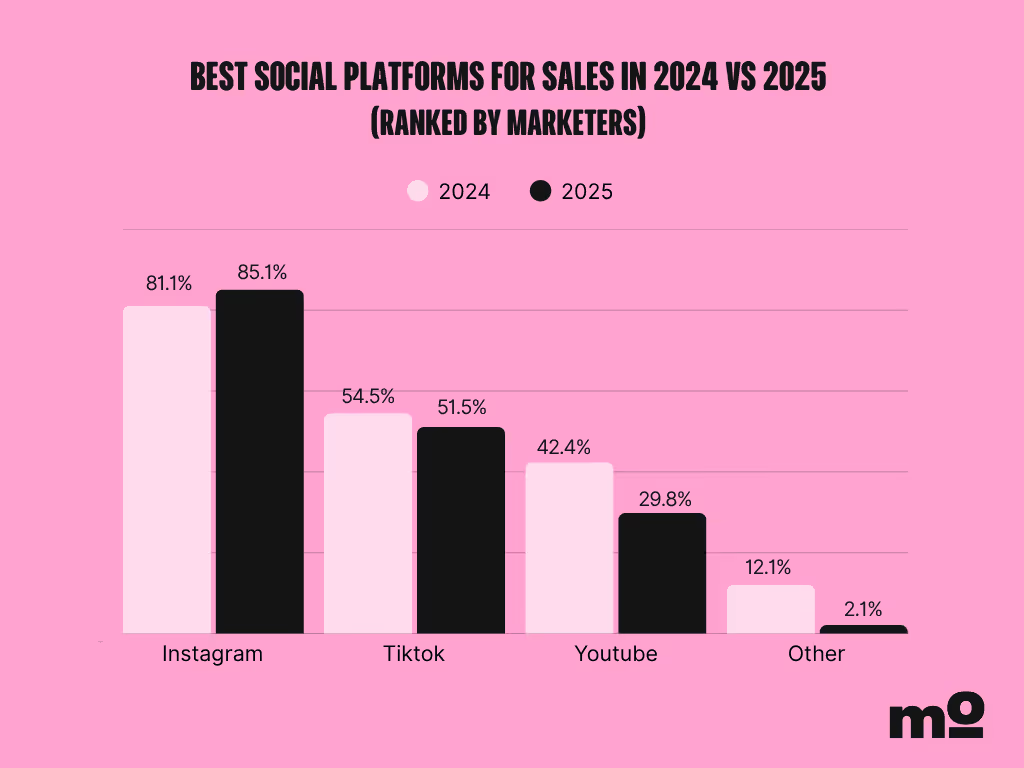
Meanwhile, YouTube dropped by 42% as a sales channel.
YouTube still performs over time, but that’s the problem. Time is what most marketers didn’t feel they had this year.
YouTube is classically a great channel for sales – as it’s a long-term investment that continues to pay dividends sometimes years after a partnership wraps.
So is YouTube failing in terms of ROI?
Far from it.
What I suspect – notice the 10% drop of “Other” in the graph – is that marketers opted for quicker wins. YouTube, in general, is a much more expensive investment, and the results aren’t always as instant.
And if you’re feeling pressure, you want the number in the spreadsheet to go higher right now.
I’ll put a pin in YouTube for the moment. It’s time to talk deliverables.
Content got shorter (and not because it worked better)
It shouldn’t be a surprise that marketers ranked Instagram Reels as their top driver of sales of 2025.
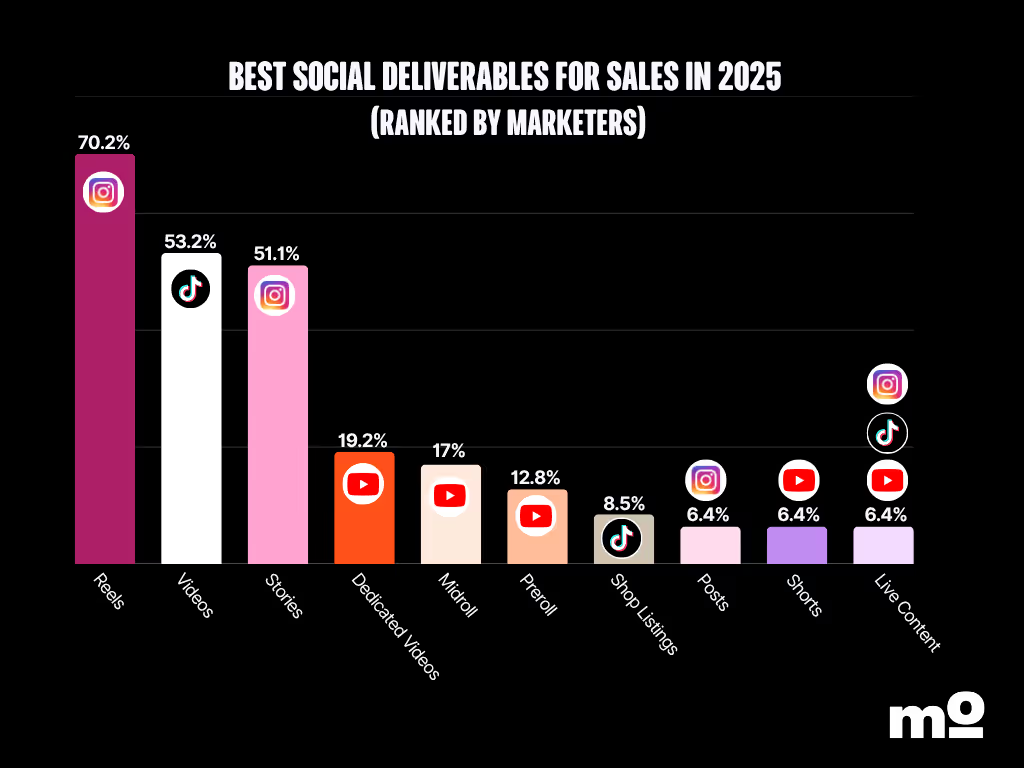
While that’s consistent from 2024, there are significant differences when we compare how marketers ranked deliverables side-by-side.
And an interesting change is that TikTok videos overtook Instagram Stories as a top deliverable for marketers.

Let’s circle back to YouTube for a second.
While marketers ranked YouTube lower for driving sales in 2025, we can see that when they did invest in YouTube, they went all-in on that investment.
This is what makes me think marketers are going for sure bets. We split integrations out this year into Pre-, Mid-, and Post-roll deliverables, and dedicated YouTube videos still ranked higher than integrated sponsored content.
This is telling – as mentioned before, YouTube deliverables, even integrations, are significantly more expensive than Instagram and TikTok deliverables. So if marketers were going to invest in YouTube, they were going to invest in very bottom-of-the-funnel, high-intent content.
In 2024, one of the biggest trends marketers predicted was that long-form content would compete with short-form in the influencer marketing industry. Nearly 70% of marketers thought long-form content was going to be big in 2025.
And they had great reasons for saying so – Shorts length were increased to 3 minutes, and Instagram followed suit with 3-minute Reels at the beginning of this year. On top of that, the YouTube algorithm began prioritizing much longer content (for the purpose of being able to show more ads), and video essays gained popularity.
In 2024, over half of marketers we surveyed said they would invest anywhere between 25-75% in long form content in 2025.
In reality, nearly half of marketers responded in 2025 that under 25% of their content was considered long-form.

And if we consider the fall in investment in YouTube as a sales channel, and their doubling down on dedicated videos when they did invest in YouTube – this checks out.
To be absolutely sure that this wasn’t a performance issue, we asked marketers how long-form and short-form content performed across brand awareness initiatives and sales.
Across the board, long-form content either out-performed short-form, or was comparable.
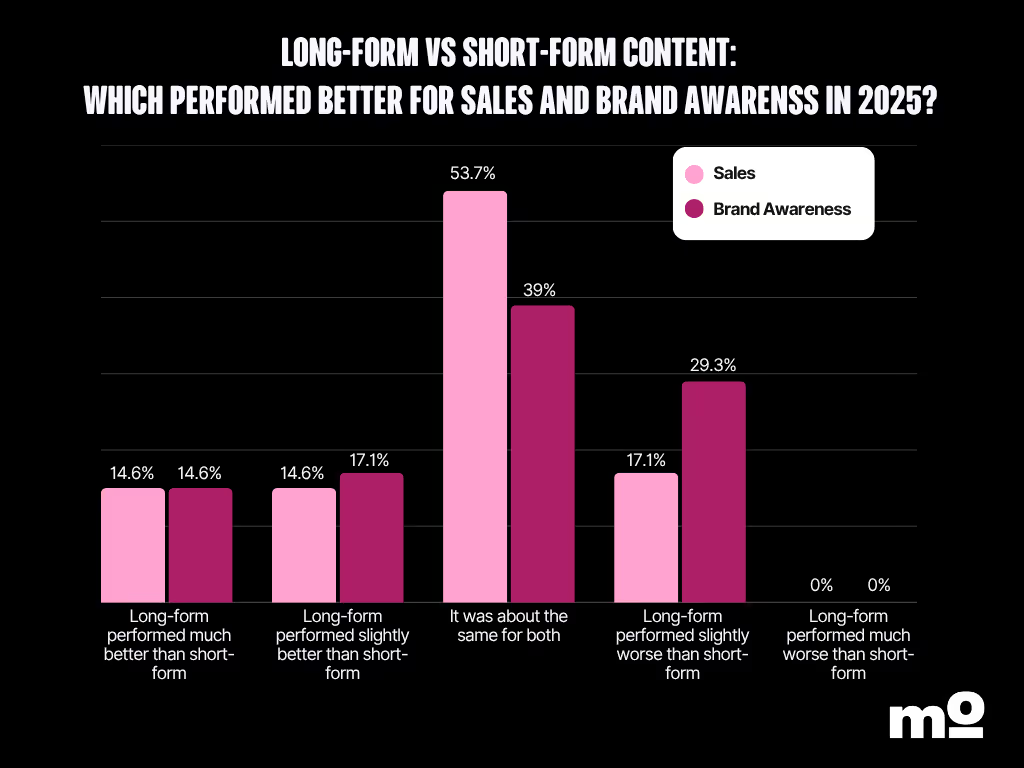
With, of course, one exception: brand awareness.
But again, it’s already hard to justify the more-expensive, long-form content for direct sales. If marketers were already feeling the pressure for performance results, chances are, this isn’t going to be a good investment for a goal with a blurrier ROI.
Especially since most of the time, it looks like marketers feel that short-form content performs on par with long-form.
But channels and deliverables weren’t the only ways marketers were more conservative with their budgets this year – the effect rippled towards creators too.
Bigger focus on smaller creators
Consolidation wasn’t limited to channels in 2025 – marketers also cut a lot of the fluff when it came to the creators they worked with.
In 2024, 8 out of 10 marketers we polled said smaller, niche creators had the best ROI – and that it was wise to focus on them in 2025. And that’s exactly what they did this year.
Just over 80% of marketers said they opted for those smaller, niche creators over larger, celebrity, general-interest influencers.
But the real question is – how did they perform?
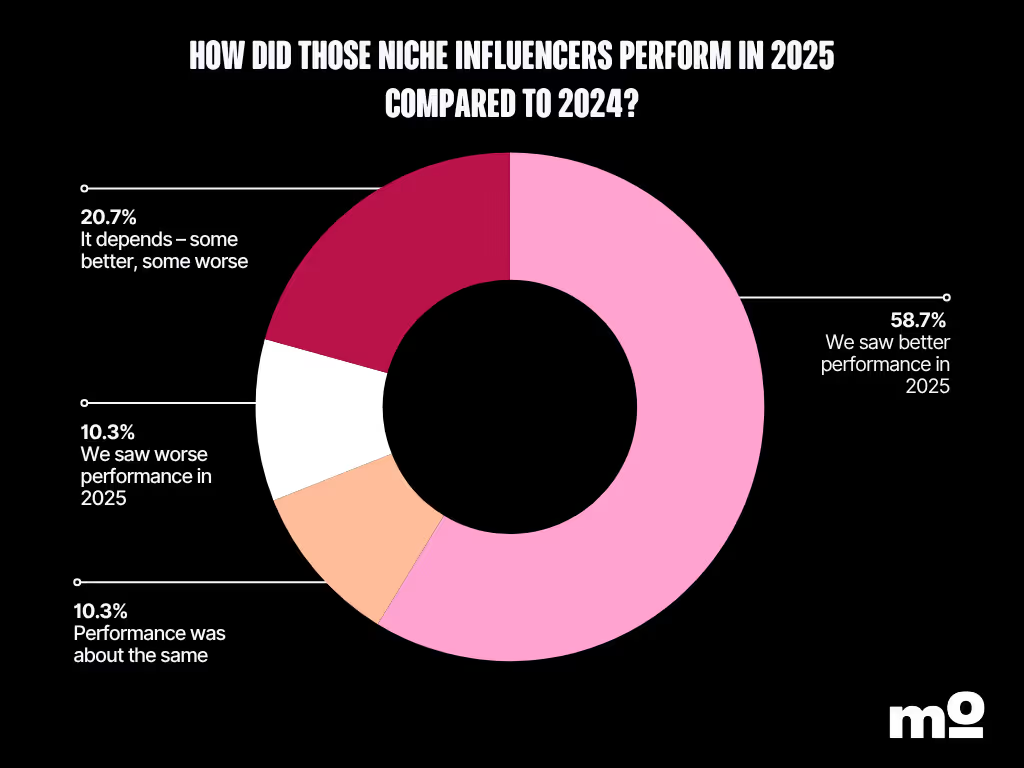
Nearly 60% of marketers saw much better performance from these niche creators in 2025 over previous years. In fact, only 1 in 10 saw worse performance for those creators, and for everyone else? It was a mixed bag.
Alice Arruda says that it wasn’t really that the creators performed better – that wasn’t surprising. They had better success because they went all-in on those creators.
Greta Zacchetti agrees – highlighting some of the unique benefits that come from working with smaller creators: more engagement, better feedback and support from their communities, and overall better prices (even if it does depend on each individual influencer).
However, according to Leslie Belen, scaling those smaller influencers is going to take more of your time.
But chances are – if you’ve got a good process for scaling your influencer collaborations quickly, like automating some of the more menial tasks, for example, you might not run into the same bottlenecks.
Pulling back commitment: the decline of long-term partnerships
While marketers heavily prioritized small creators in 2025, they were a little more hesitant to commit to long-term partnerships.
In 2024, over 75% of marketers we polled said they’d increased their long-term partnerships over the previous year. And when I asked them if they planned to run more long-term partnerships in 2025, 84.4% said they’d double down on that strategy.
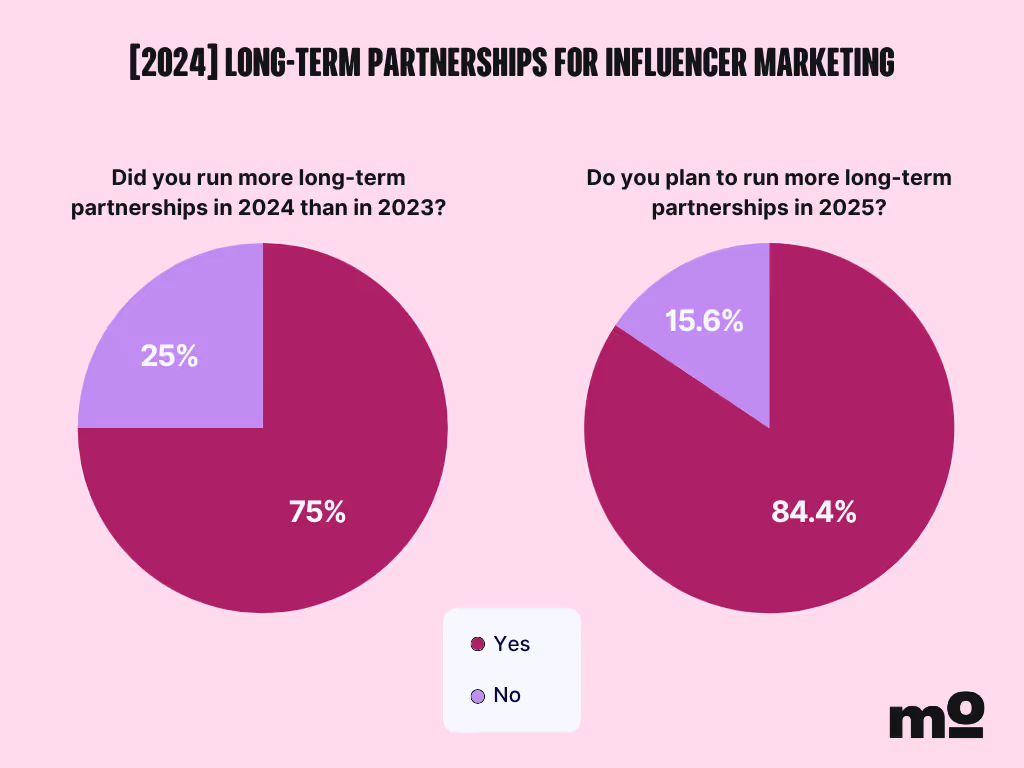
However, when push came to shove – this wasn’t always the case. Only about half of marketers actually increased their number of long-term partnerships in 2025.
And, what’s more, when I asked marketers the same question – will you be investing in more long-term partnerships in 2026, 27.9% fewer said that they’d be willing to do so.
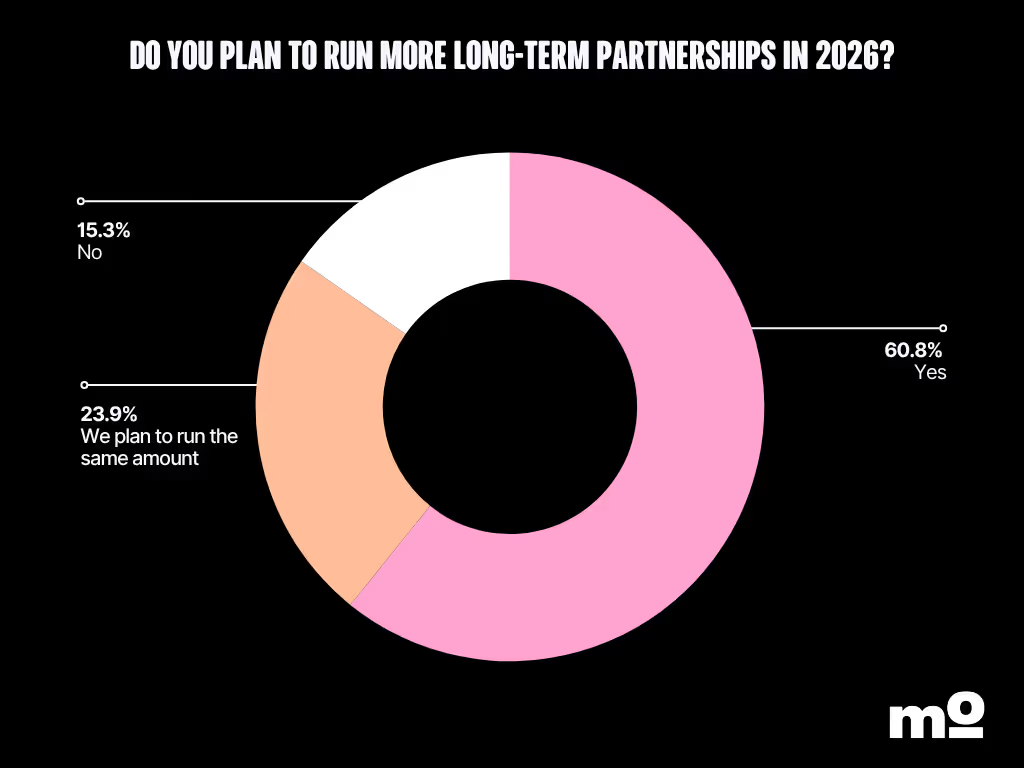
Why is the love for long-term partnerships waning for influencer marketers?
Circling back to the central theme I saw across these responses: market uncertainty makes it more difficult to commit to long-term partnerships and long-term campaigns.
Sensing economic challenges ahead, marketers chose, instead, to diversify their content in 2025 – while simultaneously consolidating their efforts into the less-expensive, quicker-turnaround deliverables and channels.
Joshua Weidling backs this up, explaining that it’s just not as simple as it used to be.
Searching for predictability: the rise of the performance model
Marketers’ need for measurable results turned into a full-blown performance obsession. Over half increased affiliate spend in 2025, but creators themselves became less open to it.
Creators want guarantees; marketers want proof.
The result: creative compensation tweaks, from fixed fees to non-monetary perks like VIP access, sneak peeks, and custom products.
In 2025, over half of marketers increased their investment in their affiliate programs.

Last year, over 63% of marketers told us they felt creators were becoming more open to affiliate work.
However, in 2025, those attitudes have shifted. Influencers now seem a lot less likely to be open to affiliate compensation models.
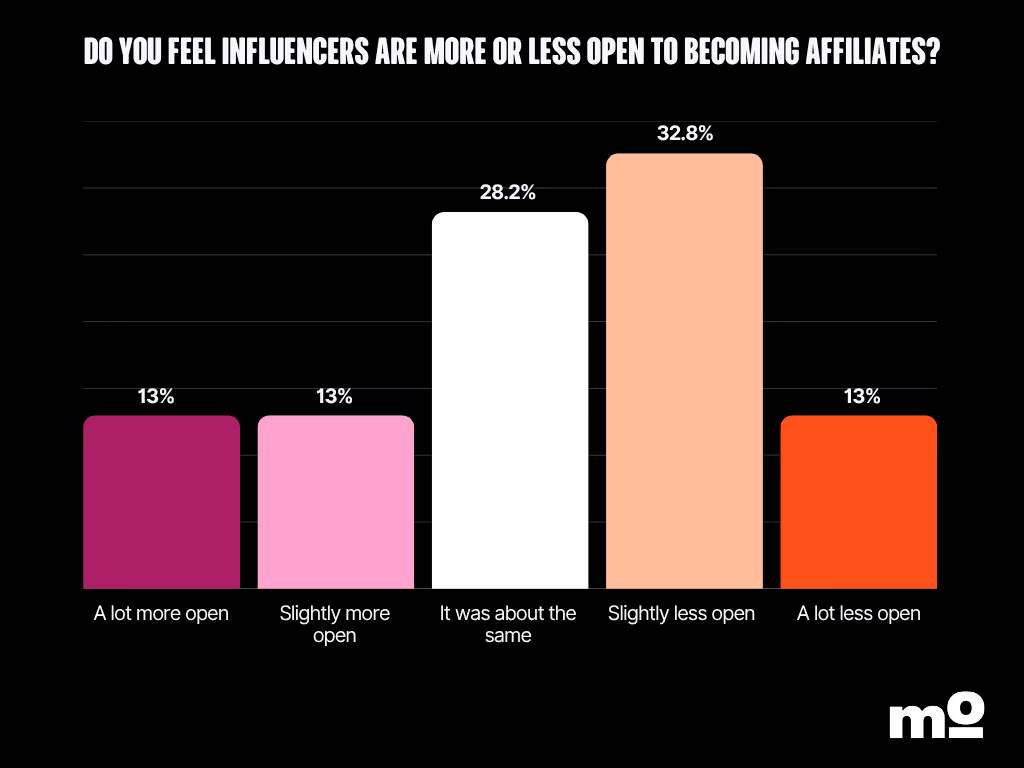
But it wasn’t just affiliate marketing that creators cooled off on – it was performance-based compensation in general.
Unless, that is, there was a fixed fee that was included.
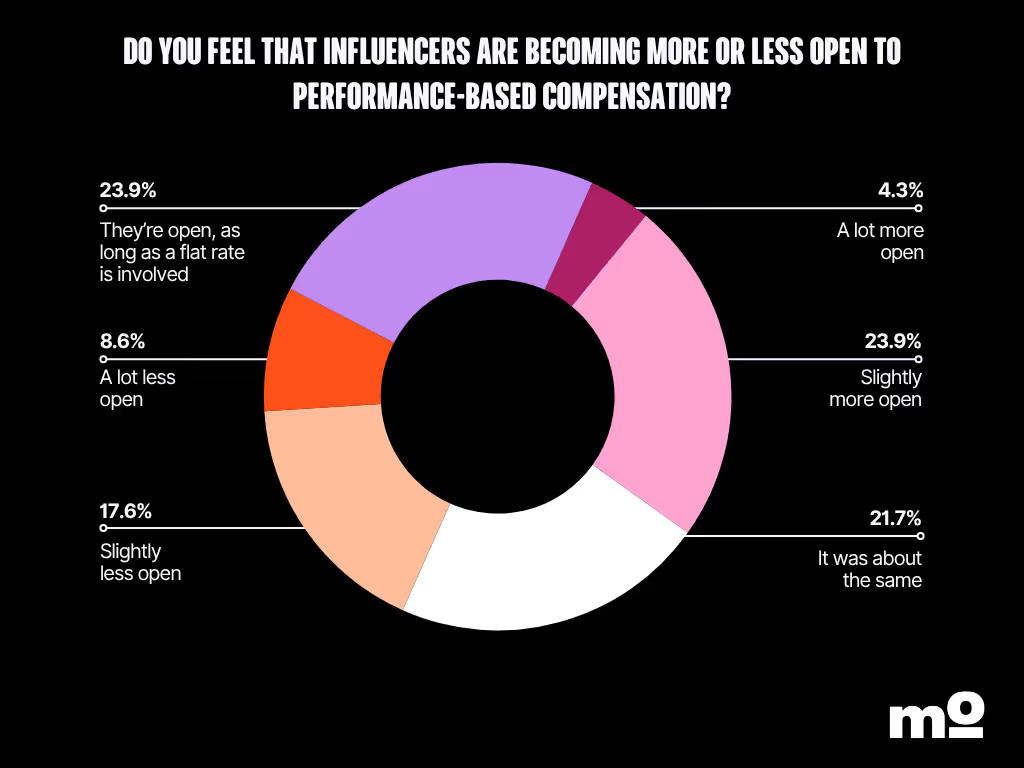
Marketers aren’t the only ones feeling the sting of the shaky economy. Influencers were far less willing to start collaborations with brands unless there was a guaranteed payout.
And honestly? Mood.
In response, many marketers got creative with non-monetary offers to help close creators. While flat fees did work to get negotiations over the finish line, marketers said that other, non-monetary incentives were best at both closing creators and generating a positive ROI.
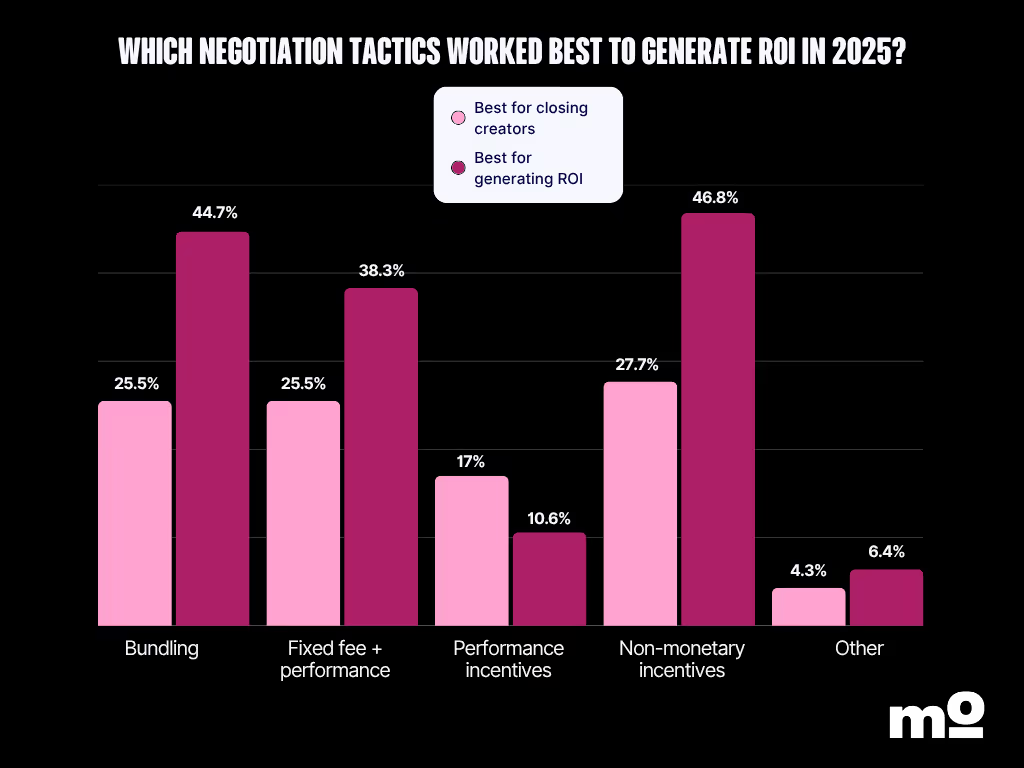
I followed up with a few people to see exactly which incentives were the most attractive to influencers:
- Sneak peeks & VIP access to new collections
- Free products
- Long-term collaborations
- PR exposure
Gabija Jankauskė explained the value of those perks. By offering influencers custom products they feel special and they post more often.
These don't feel like loopholes. They feel like survival tactics. A way for both sides to protect value in a shaky economy.
Note: This doesn’t mean you should use these tactics to undercut influencers.
Influencers are small business owners who are also struggling in this economy – especially in the US. Sweetening the deal with these incentives can help you and your influencer find common ground during negotiations.
They can also help you better secure your relationship with your influencers by delighting them with these incentives.
However, if there’s too wide a gap between the payment that your influencer needs, and what you can offer within your budget, it’s best to respect it and find another influencer to work with.
Where we go from here
The problem with uncertainty is that it can feel doom and gloom pretty quickly. However, the reality is that we aren’t entirely sure how tariffs are going to affect ecommerce companies, nor the influencer marketing industry as a whole.
But, we can see clear markers of that uncertainty:
- Marketers have a more conservative outlook with regards to their budgets, the channels they invest in, and who they work with.
- Marketers are feeling more risk-averse, instead, going after sure bets and the devils they know.
- Marketers – or rather – their teams, are chasing short-term wins and quick turnarounds as the economy becomes more unstable.
That said, there are opportunities that are being left on the table. The best way to weather the storm is to diversify your overall influencer marketing program. Much like an investment portfolio, it might feel better to consolidate your efforts into what you know works – but doing that could put you an algorithm-change from a failed campaign, month, or even quarter.
That feels risky right now. But knowledge is power, and having access to data can help you take some of the risk out of your influencer campaigns.
One thing that Modash helps with (aside from making it easier to do literally every part of your influencer management process) is offering you better data when you’re vetting influencers.
That means you’ll know:
- Engagement rates across content formats and channels
- How an influencer’s sponsored content performs compared to organic
- Who they’ve worked with in the past
- Deep audience demographics to help you match your own customer cohort
– and that’s all before you ever reach out to the influencer.
Having better access to data will help you decide just how risky a collaboration might be – and it’s really just the tip of the iceberg in terms of what the platform can do.
But don’t take my word for it. Try Modash free for 14 days (and you won’t even have to get your credit card out).


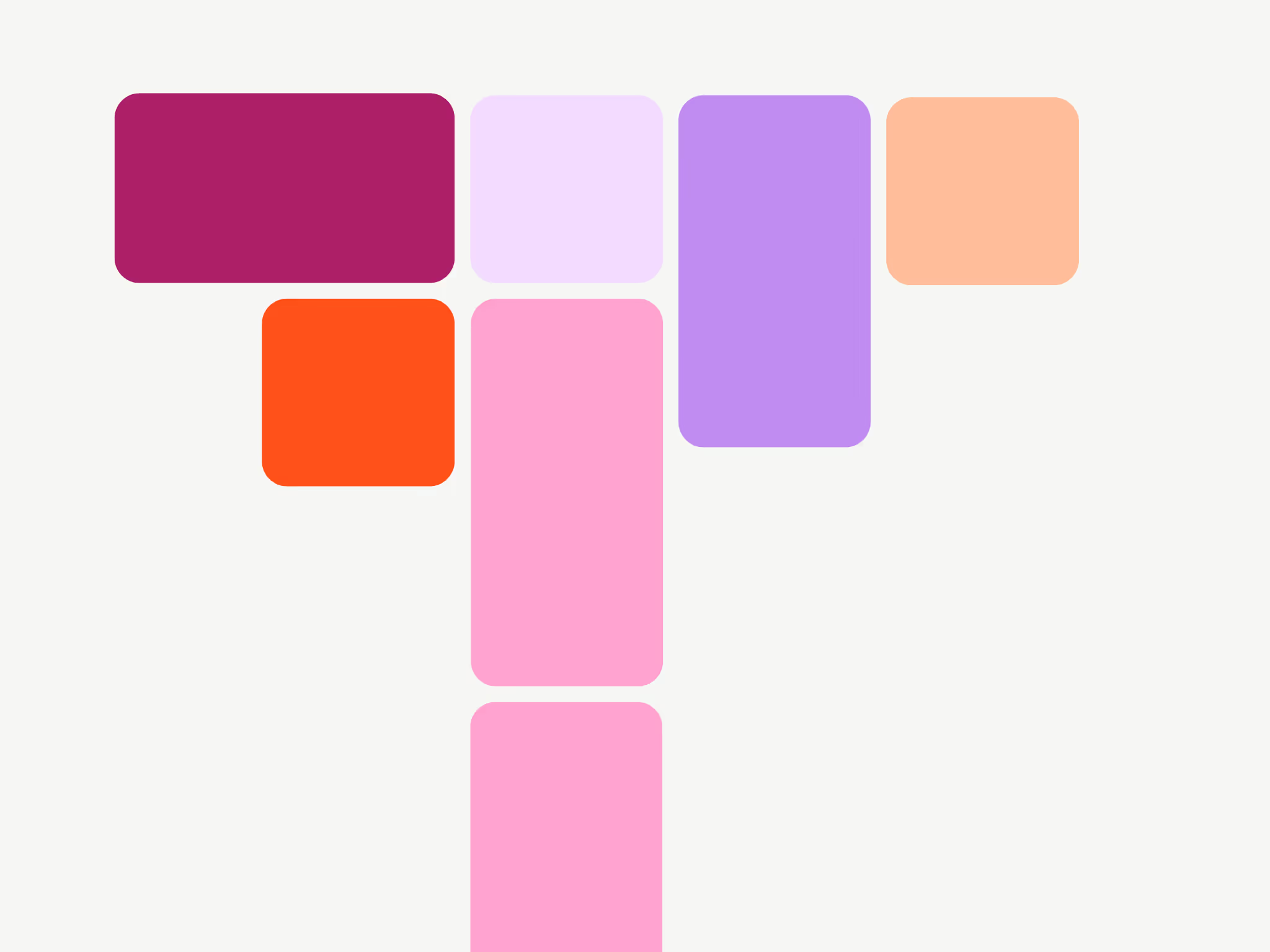





.avif)

